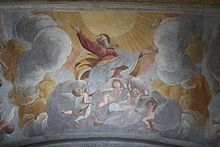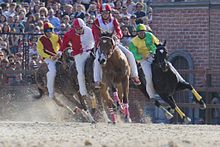Legnano
[11] Located in the south of the Varese Prealps along the Olona valley [it], the comune of Legnano has an area of 12.72 square kilometers (4.91 sq mi), has an elevation of 192–227 meters (630–745 ft) above sea level,[12] and is seismically classified [it] in Zone 4 (Irrelevant seismology).
[23] The urban fabric of Legnano has developed around the old town; its growth was influenced by three barriers: the Olona River, the strada statale del Sempione and the Domodossola–Milan railway.
The historic neighborhoods of Legnano are Mazzafame, Ponzella, Frati, Olmina, Canazza, Gabinella, Legnanello, Colli di Sant'Erasmo and Costa San Giorgio.
On the day of the patron saint san Magno, 5 November, a farmer began to contemplate the tree admiring its ability to withstand frost and snow.
[8] The ancient vicus of Legnanum, which belonged to the regio XI Transpadana, one of Italy's Augustean regions, was connected to the surrounding areas through important communication routes, the most important of which was a Roman road built in the 1st century AD, the Via Severiana Augusta, which skirted the Olona River at the modern strada statale del Sempione, which connected ancient Mediolanum (the modern Milano) to Lake Maggiore.
On the Historia Mediolanensis written by Landulf Junior in the 11th century which deals with the history of Milan in the Middle Ages, it can in fact be read that Arialdo was captured:[50] [...] iuxta locum Legnani [...]This testimony in English means "[...] near Legnano [...]".
[52] In April 1273, the Visconti Castle of Legnano hosted the royals Edward I of England and Eleanor of Castile on their way back from their trip to the Middle East.
[53][54] Bonvesin da la Riva, the greatest poet and writer of Lombardy in the 13th century and one of the exponent more prominent of the didactic poetic movement of northern Italy, lived in the city until 1288.
The literary man described Legnano with these verses:[8] [...] Among all the cities of Lombardy is lauded as the rose or lily among the flowers, such as cedar in Lebanon, as the lion among the quadrupeds, like the eagle among the birds, so as to appear as the sun among the celestial bodies, for the fertility of the soil and the availability of the necessities fundamental for the men [...]In the Middle Ages, the city was the location of the Battle of Legnano in which Emperor Frederick I was defeated by the Lombard League (1176).
Because of the historic victory of the Lombard League over Frederick Barbarossa, it is the only town other than Rome named in the Italian national anthem ("[...] Dall'Alpi a Sicilia dovunque è Legnano [...]", en.
The battle ended the fifth and final descent into Italy of Emperor Federico Barbarossa, who after the defeat tried to resolve the Italian question by attempting the diplomatic approach.
This resulted a few years later in the peace of Constance (25 June 1183), with which the Emperor recognized the Lombard League by granting administrative, political and judicial concessions to the municipalities and officially ending his attempt to hegemonize Northern Italy.
The only civil built in the 15th century that has not been demolished is Torre Colombera, which is now located between corso Garibaldi and via Del Gigante, near the Church of San Domenico, embedded in a building over the street.
[61] The low incomes that were provided by the agricultural and livestock economy of these centuries stimulated the peasants to integrate the use in the fields with other jobs, in which women also participated during the day.
The government improved the strada statale del Sempione road that connected Milan with Paris on the Rho – Legnano – Gallarate – Arona – Domodossola – Brig crossing the Alps.
She was often forced to intervene to dictate rules on agriculture, grazing and land protection, and to resolve heated disputes between farmers and millers, especially during lean Olona river periods.
[67] In 1882 the city was invaded by a disastrous flood of the Olona: for the courageous and philanthropic actions of its inhabitants, as can be read in the motivation of the honor, Legnano was awarded the Gold Medal of Civil Valor.
The secular traditions of craftsmanship and home crafting, practiced to integrate work in the fields, played a decisive role in the birth of the industry in Legnano.
Legnano was ideal for opening up textile industries thanks to the presence of important communication routes and that of the Olona River, which provided the energy necessary to move the hydraulic wheels before the installation of steam engines.
By the second half of the 19th century, the timber companies achieved a wider production, thanks in part to the technological improvement that led some industries to have an importance that transcended national borders.
Two natural disasters, in 1917, worsened the situation caused by the war: the epidemic of Spanish flu, which mowed down the population, and a devastating flood of the Olona River, which broke the embankments and invaded the town.
[78] At the end of the World War I, in 1918, Legnano was also embroiled in deep social tensions that led, at the national level, into the Biennio Rosso period first and then fascism.
[79] In the early post-war years, the timber industry resumed its strong growth which had characterized it until before the outbreak of the conflict;[78] this development took place despite the transformation of the Italian economy from liberal to corporate.
In addition to the growth of the textile and mechanical industries, in 1927 the company Emilio Bozzi took over the bicycle construction business from Franco Tosi Meccanica, relaunching the brand Legnano.
[88] In 1977 in Legnano was founded Antenna 3 Lombardia that was, that time, the most important private TV station in Italy.These alternative fields did not, however, lead to a sufficient rate of development to make up for the closure of large industrial activities.
[98] The city has the following public institutions: On 4 February 2010 the new hospital was inaugurated, located in the area of via Novara, which replaced the previous nosocomium of strada statale del Sempione.
The winning contrada of the Palio has the right to keep in its church, until the following year, a copy of the crucifix of Ariberto da Intimiano, a sculpture of 1936 by the artisan of the worker of Luciano Sai, on a scale original medieval cross.
Every year, since 2017, for about ten days, starting from the end of June, the Rugby Sound Festival takes place inside the Visconti Castle,[105] after being relocated from the municipality of Parabiago.
The event is able to combine musical performances with a variety of street food offerings The fashion house Dolce & Gabbana was founded[107] and has its administrative offices in Legnano.
[111] In Legnanese dialect there are those who find traces of the languages of the peoples prior to the Latinization of the region, in particular the ancient Ligurian, although the data on the actual influence of this linguistic substrate are few and of varying interpretation.














































